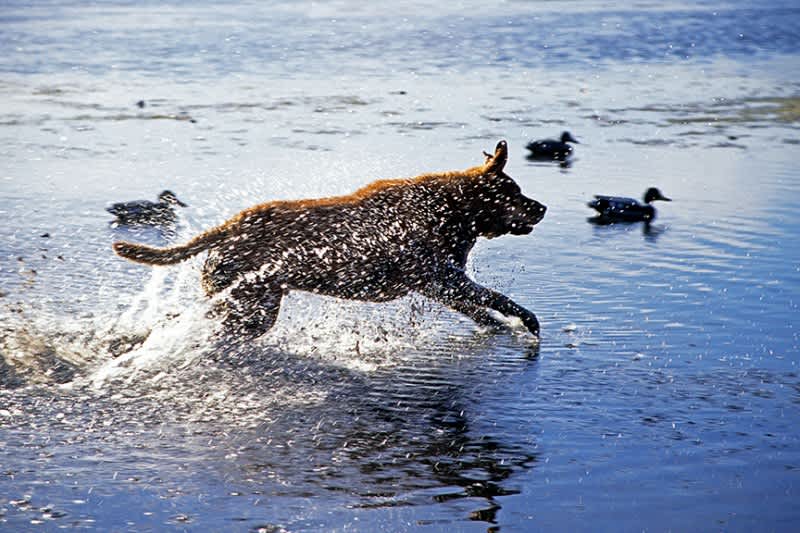Keep Your Duck ID Skills Sharp with These Tips
K.J. Houtman 09.18.14

“Don’t shoot! That’s a Can—” is not what a duck hunter wants to hear from his buddy in the blind as he pulls the trigger. Duck hunters may be a small niche subset of the hunting population, but this unique group of folks live, eat, and breathe the passion. Not all duck hunters are as famous as the Robertsons from Duck Dynasty, but a few of the avid duck hunters I talked to recently all get super excited to duck hunt every chance they can. The “avids” take duck identification to a completely new level, and woe unto the unprepared who cannot tell the difference between a mallard and a canvasback. For those of us who need to brush up on our duck identification, here are some tips from the best in the business, and why it is important to hone these skills.
On the fly
It is a lot easier to identify a duck in one’s hand after a retrieval than prior to pulling the trigger, but hard work to improve your duck identification on the fly is critically important. “Regulations are always changing and there’s no ‘party hunting’ allowed for ducks. You take responsibility for what you shoot, bag limits are personal,” said Bill Miller of Bill Miller Outdoors.
Duck hunting captured Miller’s heart and soul from an early age. Solid foundations of duck identification are extremely important to Bill; he made a set of flashcards for a best friend’s baby gift and took them to the hospital to present to the newborn. “Never too early to start,” Bill said, as he handed his friend the unusual layette addition. Miller admitted he can sound a bit like a Cliff Clavin know-it-all on ducks and duck identification, but there is a lot to learn and nuanced differences are the key. It is important to learn silhouettes, markings, and movement on the fly.

If you don’t want to make flash cards, check out these online ID quizzes from Delta Waterfowl.
Eclipse plumage
Practice duck identification on muted colors after their molt, not the vibrant spring mating presentations so often placed in duck identification primers. Bland colors make the ducks much more similar, so one has to rely on other attributes like the line and placement of white markings, the angle of the wing or tail, or the silhouette. Light is often low or conditions challenging for high definition color. “It takes practice and it is a skill you can lose if you don’t keep it honed,” continued Miller. Bright colors of ducks may be a beautiful part of their lore, but in the northland, they are rarely in that state during the early part of hunting season. Train the eye for the reality of fall colors.
It is never too late
The best way to learn or teach is through observation. “Go to where the ducks come through: at a refuge or a staging area. Watch with binoculars and observe how they move,” advised Paul Wait, editor and publisher of Delta Waterfowl magazine. Paul has been hunting ducks for 35 years and values the movement part of duck identification because light conditions often affect being able to see color or white-dark details. “Plus, ducks are flying at 35 to 40 miles per hour. It really is a challenge,” the editor with the dream job added. “How fast they move, how they trade, if their head moves up and down […] are all ways to identify ducks in formation. You can learn a lot of that by observation.”
Getting it right matters
Duck hunting isn’t usually all about the meat, although one might want to avoid shooting a merganser, for example, as their meat is not very tasty. “I could find a lot cheaper ways to put meat on the table than duck hunting,” said Miller with a smile. “Duck hunting is about the experience—all of it: scouting, decoys, calling, blinds, boats, wingshooting skills, and working with the dogs. One of the most alluring parts of the challenge for me is on-the-wing identification.” There are, of course, legal reasons for getting identification right so every hunter is in step with posted regulations. However, some hunters institute more stringent duck camp rules, like taking a “Susie” (a hen mallard) means throwing a hundred bucks into the camp kitty. Taking a hen might be legal, but camp rules carry their own penalty.

Even amongst the best duck hunters, mistakes happen. Learn from them, own them, and hopefully it will never happen again. Make perfecting this important element of waterfowling part of each year’s preparation. After all, growing in knowledge is a great way to spend the off-season months. Teach kids about this, too; they love interesting facts about nature and wildlife and often are willing students.
K.J. Houtman is the author of the award-winning Fish On Kids Books series, chapter books for eight- to 12-year-olds with adventures based around fishing, camping, and hunting. Her work is available at Amazon and local bookstores. Find out more at fishonkidsbooks.com.

